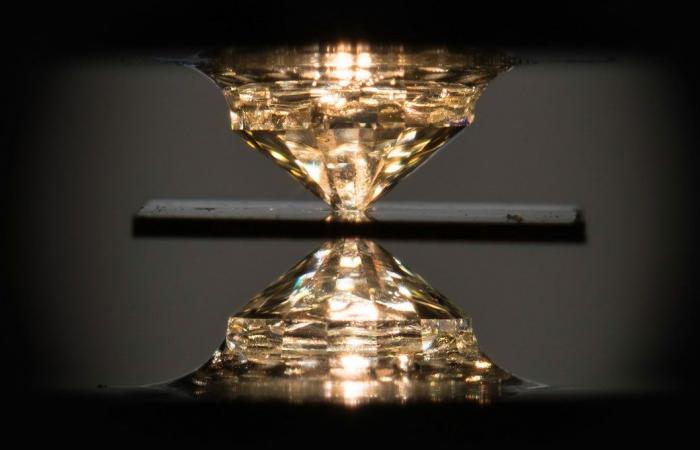Original story courtesy of Quanta Magazine, an editorially independent publication of the Simons Foundation, whose mission is to improve the public’s understanding of science by addressing research developments and trends in mathematics, physics and life sciences.
“This is the first time that we can truly claim that superconductivity was found at room temperature,” said Ion Errea, a condensed matter theorist at the University of the Basque Country in Spain who was not involved in the work.
“It is clearly a milestone,” said Chris Pickard, materials scientist at Cambridge University. “This is a cool room, maybe a British Victorian cottage,” he said of the 59-degree temperature.
As researchers celebrate this success, they emphasize that the newly discovered compound, developed by a team led by Ranga Dias of the University of Rochester, will never get into lossless power lines, smooth high-speed trains, or any of the revolutionary technologies that could be ubiquitous if the fragile quantum effect underlying superconductivity could be maintained under real environmental conditions. This is because the substance only superconducts at room temperature, while it is crushed between two diamonds to a pressure that is about 75 percent as extreme as that in the earth’s core.
“People have always talked about room temperature superconductivity,” Pickard said. “You may not have fully appreciated that we would do it under as much pressure as we did.”
Materials scientists are now faced with the challenge of discovering a superconductor that works not only at normal temperatures, but also under everyday pressure. Certain features of the new compound give hope that one day the right atomic mix will be found.
Electrical resistance occurs in normal wires when free flowing electrons collide with the atoms that make up the metal. However, researchers discovered in 1911 that electrons can induce vibrations in the atomic lattice of a metal at low temperatures, and these vibrations in turn pull electrons together into pairs known as Cooper pairs. Different quantum rules apply to these pairs, which flow together in a cohesive swarm that runs unhindered through the metal grid and does not experience any resistance. The superconducting fluid also emits magnetic fields – an effect that could allow magnetically levitated vehicles to float smoothly over superconducting rails.
However, when the temperature of a superconductor rises, the particles randomly wobble and break up the delicate dance of electrons.
Researchers have spent decades looking for a superconductor whose Cooper Tango mates tightly enough to withstand the heat of everyday environments. Neil Ashcroft, a solid-state physicist at Cornell University, suggested in 1968 that a lattice of hydrogen atoms would do the trick. Due to the small size of the hydrogen, the electrons approach the nodes of the lattice and strengthen their interactions with the vibrations. The lightness of hydrogen also allows these guide shafts to vibrate faster, further strengthening the glue that binds the Cooper pairs.
Impractically high pressures are required to squeeze hydrogen into a metal mesh. Still, Ashcroft’s work raised hopes that some “hydride” – a mixture of hydrogen and a second element – might provide the superconductivity of metallic hydrogen at more accessible pressures.
Advances accelerated in the 2000s, when theorists could use supercomputer simulations to predict the properties of various hydrides and the widespread use of compact diamond anvils allowed experimenters to squeeze the most promising candidates together to test their skills.
Suddenly hydrides set records. In 2015, a team in Germany showed that a metallic form of hydrogen sulfide – a sharp compound in rotten eggs – is superconducting at -94 degrees Fahrenheit below 1.5 million times atmospheric pressure. Four years later, the same lab used lanthanum hydride to get -10 degrees below 1.8 million atmospheres, even when another group found evidence of superconductivity in the same compound at 8 degrees.
Dias’ laboratory in Rochester has now destroyed these records. Using intuition and rough calculations, the team tested a number of hydrogen compounds to find the Goldilocks ratio of hydrogen. If you add too little hydrogen, a compound will not be as robustly superconducting as metallic hydrogen. If you add too much, the sample will act too strongly like metallic hydrogen and will only metallize at pressures that crack your diamond anvil. In the course of their research, the team has blasted many dozen pairs of diamonds valued at $ 3,000. “That’s the biggest problem with our research, the diamond budget,” said Dias.
These were the details of the news Scientists discover the first superconductor at room temperature for this day. We hope that we have succeeded by giving you the full details and information. To follow all our news, you can subscribe to the alerts system or to one of our different systems to provide you with all that is new.
It is also worth noting that the original news has been published and is available at de24.news and the editorial team at AlKhaleej Today has confirmed it and it has been modified, and it may have been completely transferred or quoted from it and you can read and follow this news from its main source.

